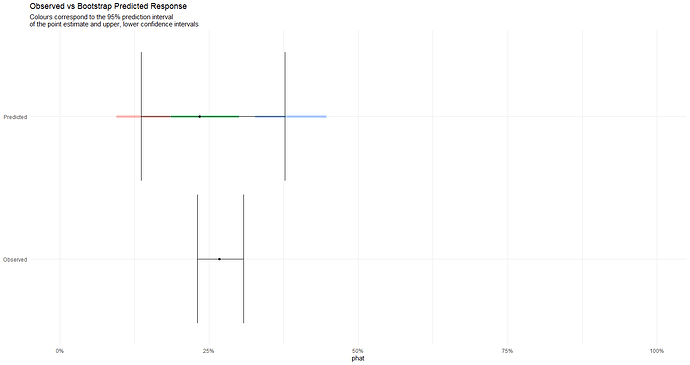i used this solution in the end. The end result gives the VPC for the predicted response, where the segments represent the 95% prediction intervals for the estimated CI based on the model tuned in the training part.
If there is a simpler way to do that then i'm happy to rework the logic 
Targets Pipeline to prep the data
pipe_model_prep <- tar_pipeline(
tar_target(model_data,
pred_setup(subset_hamd,subset_adsl,lb_predict)),
tar_target(model_split, {
set.seed(3456)
initial_split(model_data, strata = RESPONSE)
}),
# Prepare Data
tar_target(model_train,
training(model_split)),
tar_target(model_cv,
rsample::vfold_cv(model_train, strata = RESPONSE)),
tar_target(model_boot,
rsample::bootstraps(model_train, strata = RESPONSE)),
# Prepare Recipe
tar_target(model_rec,{
prepare_recipe(model_train)
})
)
Targets Pipeline to fit the model
pipe_logistic_model <- tar_pipeline(
tar_target(logistic_tune, {
logistic_reg(penalty = tune(),mixture = tune()) %>%
set_engine('glmnet')
}),
tar_target(logistic_workflow,{
workflow() %>%
add_recipe(model_rec)%>%
add_model(logistic_tune)
}),
tar_target(logistic_fit,{
set.seed(2020)
tune_grid(
logistic_workflow,
resamples = model_boot,
grid = dials::grid_regular(dials::penalty(),
dials::mixture(range = c(0.5,1)),
levels = c(50,5)),
metrics = yardstick::metric_set(yardstick::roc_auc,
yardstick::accuracy)
)
}),
tar_target(logistic_best_workflow,{
finalize_workflow(
logistic_workflow,
logistic_fit%>%select_best(metric = 'roc_auc')
)
}),
tar_target(logistic_last_fit,{
logistic_best_workflow%>%
last_fit(split = model_split)
}),
tar_target(logistic_best_fit,{
logistic_best_workflow%>%
fit(model_train)%>%
pull_workflow_fit()
})
)
model_test <- testing(model_split)
model_boot_test <- rsample::bootstraps(model_test, strata = RESPONSE)
#create vpc based on best model
vpc_boot <- model_boot_test%>%
dplyr::mutate(
test_data = purrr::map(splits,testing),
pred = purrr::map(test_data,function(object,wf){
wf%>%
fit(data = object)%>%
predict(new_data = object)%>%
dplyr::mutate(observed = object$RESPONSE)
},wf = logistic_best_workflow)
)
# calc binomial ci based on Wilson's method
vpc_boot_unnest <- vpc_boot%>%
dplyr::mutate(
pred_ci = purrr::map(pred,function(x){
binom.confint(x = sum(x$.pred_class=='[3,4,5]'),
n = nrow(x),method = 'wilson')%>%
tibble::as_tibble()
})
)%>%
dplyr::select(id,pred_ci)%>%
tidyr::unnest(c(pred_ci))
obs_ci <- binom.confint(x = sum(model_data$RESPONSE=='[3,4,5]'),
n = nrow(model_data),
method = 'wilson')%>%tibble::as_tibble()
dat <- dplyr::bind_rows(
obs_ci%>%
dplyr::mutate(id = 'Observed',type = 'Observed'),
vpc_boot_unnest%>%dplyr::mutate(type = "Predicted")
)%>%
dplyr::rename(point = mean)
# melt the data into quantiles
melt_quant <- function(x,probs = c(0.05,0.5,0.95)){
x%>%
quantile(probs = probs)%>%
tibble::as_tibble()%>%
dplyr::mutate(q = probs)%>%
list()
}
dat1 <- dat%>%
dplyr::group_by(type)%>%
dplyr::summarise(dplyr::across(c(point,lower,upper),list(ci = melt_quant)))%>%
tidyr::pivot_longer(-type)%>%
tidyr::unnest(c(value))
pt_dat <- dat1%>%dplyr::filter(q==0.5)%>%tidyr::pivot_wider(names_from = name,values_from=value)
#plot the vpc
ggplot() +
geom_path(aes(x = value,colour = name,y= type),size = 2,alpha = 0.5,
data = dat1%>%dplyr::filter(type=='Predicted'&q!=0.5)) +
geom_errorbarh(aes(y = type,xmin= lower_ci,xmax = upper_ci),
data = pt_dat) +
geom_point(aes(x = point_ci,y = type),data = pt_dat) +
labs(
title = 'Observed vs Bootstrap Predicted Response',
subtitle = 'Colours correspond to the 95% prediction interval\nof the point estimate and upper, lower confidence intervals',
x = 'phat',y=NULL,colour = 'Predicted') +
scale_x_continuous(labels = scales::percent,limits = c(0,1)) +
theme_minimal() +
theme(legend.position = 'none')
